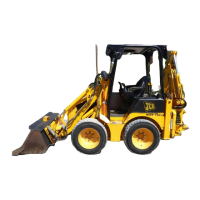
Do you have a question about the jcb 1CX and is the answer not in the manual?
| Brand | jcb |
|---|---|
| Model | 1CX |
| Category | Compact Loader |
| Language | English |
Lists the contents of Section 1.
Explains how to identify the machine using plates and serial numbers.
Provides torque specifications for various bolts and adapters.
Lists tools numerically with their corresponding page numbers.
Lists and describes JCB sealing and retaining compounds.
Lists the contents of Section 2.
Explains signal words like DANGER, WARNING, and CAUTION.
Covers general safety practices including decals, alcohol, clothing, and alertness.
Provides safety guidelines for operating the machine.
Covers safety precautions during maintenance and repairs.
Explains the importance and use of safety decals on the machine.
Lists the contents of Section 3.
Specifies fluids, capacities, and lubricants for various machine systems.
Covers health and safety aspects of handling lubricants.
Discusses fuel types, standards, and filling procedures.
Outlines maintenance tasks based on operating hours.
Explains how to install and remove the loader arm safety strut.
Provides instructions for greasing the machine's pivot points.
Covers battery safety, maintenance, and electrolyte level checks.
Covers checking hydraulic fluid levels and changing the hydraulic filter.
Details drive chain lubrication and checking oil levels.
Covers tyre inflation, wheel bolt torques, and non-inflatable tyres.
Covers air filter replacement procedures.
Lists the contents of Section A.
Explains how to connect and disconnect flat face quick release couplings.
Describes safe procedures for connecting and disconnecting hydraulic hoses.
Covers daily maintenance for general purpose and 6-in-1 shovels.
Covers daily maintenance for pallet forks, including safety and damage checks.
Covers daily maintenance for manure/silage forks.
Covers daily maintenance for attachment frames.
Lists the contents of Section B.
Details the removal and replacement of floor plates.
Covers the removal and replacement of the loader arm.
Covers the removal and replacement of the dipper.
Covers the removal and replacement of the boom.
Exploded view of the kingpost assembly components.
Lists the contents of Section C.
Provides technical specifications for battery, alternator, and light bulbs.
Lists fuses and their ratings for circuit protection.
Describes various sensing switches used in the electrical system.
Explains how to use a multimeter for testing electrical components.
Covers battery safety precautions and maintenance procedures.
Covers service precautions and charging tests for the alternator.
Details starting circuit tests and removal/replacement procedures.
Lists main components, lamps, and fuses for the electrical circuit.
Lists the contents of Section D.
Details the description, removal, and adjustment of hand and foot throttles.
Covers throttle cable removal, replacement, and adjustment.
Lists the contents of Section E.
Provides technical specifications for pumps, motors, and joysticks.
Describes safe procedures for connecting and disconnecting hydraulic hoses.
Discusses hydraulic fluid quality, contamination effects, standards, and filters.
Provides general description of the hydraulic circuit and machine neutral circuit.
Explains the pressure relief operation of the excavator valve.
Explains the hydraulic circuit during neutral transmission operation.
Details the operation and adjustment of the pressure reducing solenoid valve.
Explains the operation of the drive motors, including flushing circuits.
Explains the hydraulic circuit during forward transmission operation.
Provides a troubleshooting guide for hydrostatic transmission problems.
Covers dismantling and assembly of the hydrostatic pump.
Troubleshooting guide for hydrostatic pump issues like machine veering.
Describes procedures to check for faulty pumps or motors.
Explains how to check motor leakage rates to diagnose wear.
Guides on checking joystick hydraulic supply and return lines.
Covers dismantling and assembly of standard auxiliary pumps.
Covers dismantling and assembly of high-flow auxiliary pumps.
Exploded views of drive motor components.
Troubleshooting guide for hydraulic problems in loader/excavator circuits.
Details the removal and replacement of the loader valve.
Covers removal, dismantling, assembly, and testing of relief valves.
Explains the operation, testing, and adjustment of the check valve.
Covers dismantling, assembly, check valves, spools, and relief valves.
Details the dismantling and assembly of the hydraclamp valve.
Explains the operation and adjustment of the pressure reducing solenoid valve.
Details the dismantling and assembly of the brake valve.
Covers removal and replacement of the joystick units.
Exploded view of ram components.
Details re-sealing and filling procedures for the slew cylinder.
Covers the removal and replacement of the hydraulic filter.
Covers the removal and replacement of the suction strainer.
Component key for the standard machine hydraulic circuit.
Component key for standard machine hydraulic circuit with single lever drive.
Component key for high-flow machine hydraulic circuit with single lever control.
Component key for high-flow machine hydraulic circuit with dual lever drive.
Component key for high-flow machine hydraulic circuit with single lever control.
Component key for high-flow machine hydraulic circuit with single lever drive.
Component key for high-flow machine hydraulic circuit with single lever control.
Component key for high-flow machine hydraulic circuit with dual lever drive.
Component key for high-flow machine hydraulic circuit with dual lever drive.
Describes the optional hand tool hydraulic circuit.
Lists the contents of Section F.
Covers removal and replacement of roadwheels.
Covers removal, replacement, dismantling, and assembly of wheel hubs.
Lists the contents of Section G.
Procedures for preparing the machine for towing or winching.
Lists the contents of Section K.
Provides technical data for the XUD engine.
Details the removal and replacement of the engine.
